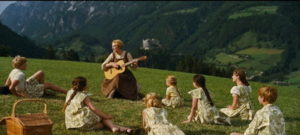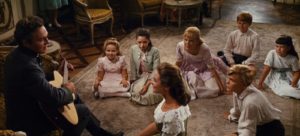
The Sound of Music was released in 1965 and was produced and directed by Robert Wise in a form of a musical drama film. The film illustrates the way that music, lead by Maria, brings happiness back to the Von Trapp family and finally helps them escape from the powerful Nazis. By emerging music back into the family’s lives, Maria continues to convince people to understand that music has a mighty power to change even the most delicate situations into stronger family bonding and romantic feelings.
For the story of the Von Trapp family and of the events leading up to their concert attraction just prior to World War II and their fleeing from the Nazis, Wise in fact went to the actual locale, Salzburg, and spent 11 weeks filming his action among the pageantry of the Bavarian Alps. He caught the beauty and fascination of the terrain with his facile cameras, combining the gorgeous towering mountains and quiet lakes with the Old World grace of the historic City of Music, a great complement to interiors shot in Hollywood. One of the scenes that stood out was the sequence of the famous Salzburg Festival, which was actually shot in the spectacular Felsenreitschule, or Rocky Riding School. The stage of the vast amphitheatre is backgrounded by scores of arched tunnels carved out of the rocky mountain that surrounds the city and it forms an fantastic backdrop for the climactic scenes of the film, which then shows the Von Trapp family escaping after their appearance onstage while storm troopers are waiting for them in the audience.
There is no surprise that the music plays a huge narrative tool, but in also in corporation with wide shot visuals. This is especially shown when Maria made the children clothes from her window curtains and took them out into town. There is a long shot that audiences can see the beautiful mountains and the seven children all dressed in floral window drapes that shows, in hopes of the producer, the beauty in the family bonding in beautiful clothing within an open space in contrast to the uniforms their father insisted them to wear everyday inside the house. More interestingly, Maria then taught the children a music lesson on the seven keys – Do, Re, Mi, Fa, Sol, La, Ti. The Sound of Music purposely integrated this concept to show that each of the seven children have their own wider role in the family bond just as the seven keys of the music. When each of the keys take turns to sound or sound in harmony, they compose beautiful music all together.
Another pivotal scene that demonstrates this concept is in a later scene where the seven children form a choir to sing a ballad for their father’s potential suitor. The assembly of the children singing definitely was the catalyst in reminding Captain Von Trapp what peace music can bring. Using a medium shot, we see Captain Von Trapp’s emotional reaction to his children singing together in harmony. We then get a cutaway to the children singing, only to go back to Captain Von Trapp slowly entering the room to join the assembly. Within this sequence, the audience can see the father soften through the sound of music, which is something we have not seen before in the film until now. It does not even end there when we actually get to see the father play the guitar and sing to the children himself, embodying the bonding element Mariah always had with the children.

Despite all of the film’s stunning visual storytelling in family bonding, there were still however unforgiving critics who absolutely despised the beloved classic. It’s a historical context definitely added an extra intrigue to the Sound of Music phenomenon. Back in 1965, film critic Pauline Kael called The Sound of Music “the sugar-coated lie that people seem to want to eat.” She even goes on to say, “We have been turned into emotional and aesthetic imbeciles when we hear ourselves humming the sickly, goody-goody songs.” Many more harsh critics agreed with Kael. The New York Times’ Bosley Crowther’s initial review included calling out the film’s “cosy-cum-corny” direction and the plot’s “romantic nonsense and sentiment.” Soon after the film’s release, he posited that The Sound of Music would destroy the movie-musical genre, considering the excellence of West Side Story and My Fair Lady.
It was more bitter than sweet to entangle my enjoyment watching the film with the harsh critics’ words during the time of the release but the musical continues to stand the test of time and touch many people’s hearts till this day. Even if there are those who don’t see or feel the beauty of the film, at least they can hear the family sing the sound of music.
Sources:
https://www.thedailybeast.com/everyone-hated-the-sound-of-music?ref=scroll
